-
Countries
-
Data and Analysis
-
Special Focus
-
Crisis Responses
Return Intention
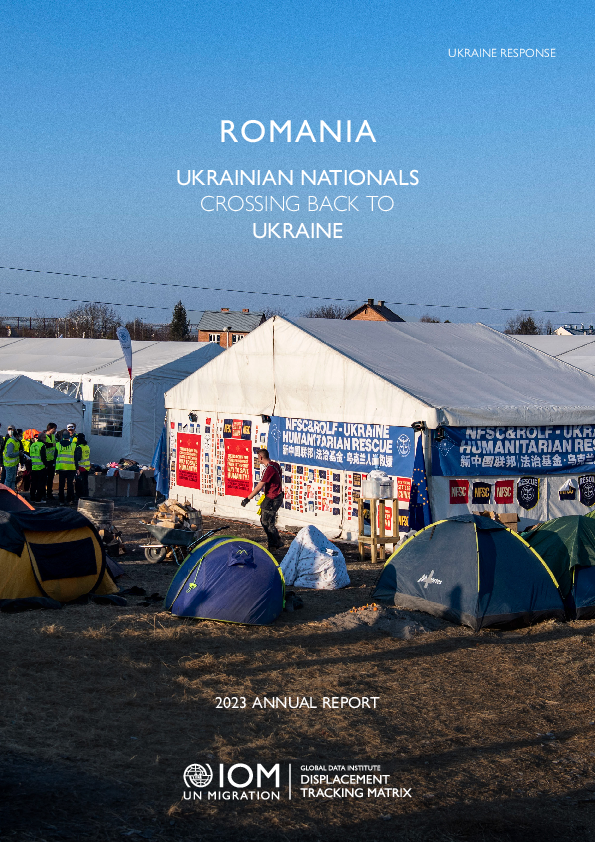
Contact
DTM Europe, DTMMediterranean@iom.int
Language
English
Location
Romania
Period Covered
Jan 01 2023
Dec 31 2023
Activity
- Survey
- Return Intention
- Flow Monitoring
This report employs data collected within the framework of the Crossing Back surveys conducted in Romania between January and December 2023 with Ukrainian nationals who were either crossing back for a short-time visit or returning for a long-term period to Ukraine from or through Romania. The analysis considers ‘’short-term visitors’’ those persons who intended to spend 0-30 days in Ukraine, while respondents planning to stay for more than a month are defined as “prospective returnees”.
The survey included answers from 5,773 Ukrainian nationals living in or passing through Romania who were travelling to Ukraine. Among those interviewed before crossing back into Ukraine, the majority stayed in Romania (59%), followed by Bulgaria (17%) or Germany (5%). Additional countries of residence included Italy (4%), the United Kingdom of Great Britain and Northern Ireland (3%), Türkiye (2%), Belgium (2%), Greece (1%), Austria (1%), with the remaining 6% distributed among other nations.
The travel intentions of the surveyed Ukrainian nationals show that most respondents (53%) were “short-term visitors”, while 27 per-cent were prospective returnees. Another 20 per cent were not sure regarding their visit period. Also, most UA citizens were travelling back to their oblast of origin (93%), with most respondents originating from Odeska, Chernivetska, Mykolaivska, Ivan-Frankivska, City of Kiyv and Kharvivska.

Contact
DTM Iraq, IraqDTM@iom.int
Language
English
Location
Iraq
Period Covered
Mar 01 2016
Jun 30 2021
Activity
- Survey
- Community Perception
- Return Intention
- Mobility Tracking
- Baseline Assessment
What happens to households experiencing protracted displacement during a global pandemic? This is not a question that Access to Durable Solutions Among IDPs in Iraq, a panel study conducted by IOM and Georgetown University, initially anticipated answering at its inception six years ago.1 Yet this question is one the study is uniquely positioned to answer. The mixed-method project collects data from surveys and interviews to understand how the same Iraqi IDP households displaced by the conflict with the Islamic State in Iraq and the Levant (ISIL) try to access a “durable solution” to their displacement as defined by the Inter-Agency Standing Committee’s Framework on Durable Solutions. Conducted among the non-camp population of IDPs displaced between 2014 and 2015, the study operationalized the eight criteria that collectively measure a durable solution: safety and security, standard of living, livelihood, housing, access to documentation, family reunification, participation in public affairs, and access to justice. Using each of these criteria over six rounds of data collection, the study has tracked changes in what challenges IDP households face and the solutions they engineer as they search for a durable solution to their displacement. Based on findings from the newest, sixth round of data collection, this report details not only how COVID-19 affects IDPs, but specifically, and in keeping with the purpose of the study, how the COVID-19 pandemic affected IDP households’ abilities to achieve a durable solution. This latter endeavor entails two tasks: first, to identify what challenges persist because they existed pre-COVID-19 (and are thus primarily displacement-related), and second, to identify what challenges the COVID-19 pandemic has created or made worse. The longitudinal nature of the Access to Durable Solutions study and its ability to compare current findings with past trends using the same indicators facilitated disentangling and completing these two tasks
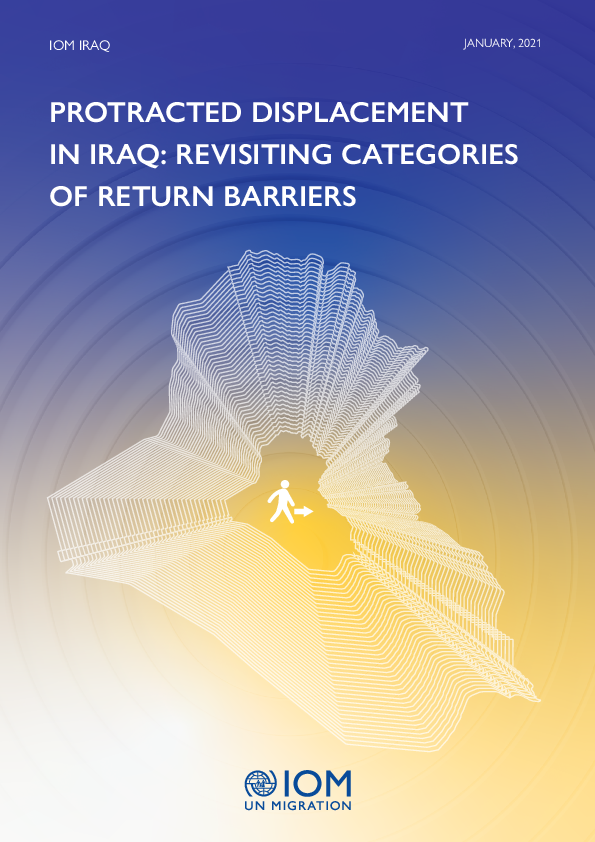
Contact
DTM Iraq, IraqDTM@iom.int
Language
English
Location
Iraq
Snapshot Date
Dec 31 2021
Activity
- Survey
- Return Intention
- Mobility Tracking
- Baseline Assessment
This report, Protracted Displacement in Iraq: Revisiting Categories of Return Barriers, is the second in this series and draws upon new literature and data that has been collected since Categorizing Protracted Displacement in Iraq was published. The aim of this report is to provide an updated evidence base to inform continued strategy development and monitoring relating to the resolution of IDPs in protracted displacement, through: • Providing an updated overview of the current IDP context in Iraq Providing an updated categorization framework and highlighting the different types of barriers faced by IDPs in returning to their areas of origin
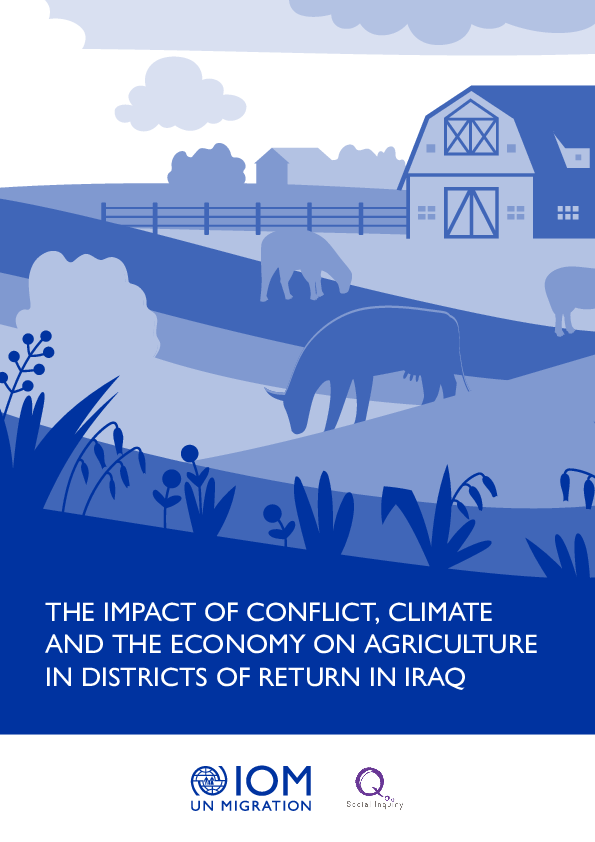
Contact
DTM Iraq, IraqDTM@iom.int
Language
English
Location
Iraq
Period Covered
Mar 01 2022
Apr 30 2022
Activity
- Survey
- Return Intention
- Mobility Tracking
- Baseline Assessment
This brief is part of a larger research project, Reimagining Reintegration, carried out by IOM Iraq and Social Inquiry, that explores the sustainability of returns across 14 districts hosting the largest shares of returnees in the country. These are, in descending order of returns, Mosul, Ramadi, Falluja, Telafar, Tikrit, Heet, Hawija, Hamdaniya, Shirqat, Kirkuk, Baiji, Sinjar, Khanaqin, and Balad. The findings presented here are drawn from an original household survey and roster of 2,260 returnee respondents in these districts collected between March and April 2022. The survey included a household module (applicable to the overall household situation), a personal module (gathering perceptions of the respondent), and a roster module (collecting personal characteristics of each household member), covering topics related to demographics, displacement and conflict history, safety and security, adequate standards of living, livelihoods and economic conditions, housing condition/restitution and tenure security, civil documentation, social cohesion and public participation, and remedies and justice. The outputs of this project also include an analysis of sustainable reintegration in districts of return and another brief on differences between male- and female-headed households and their implications for sustainable return.
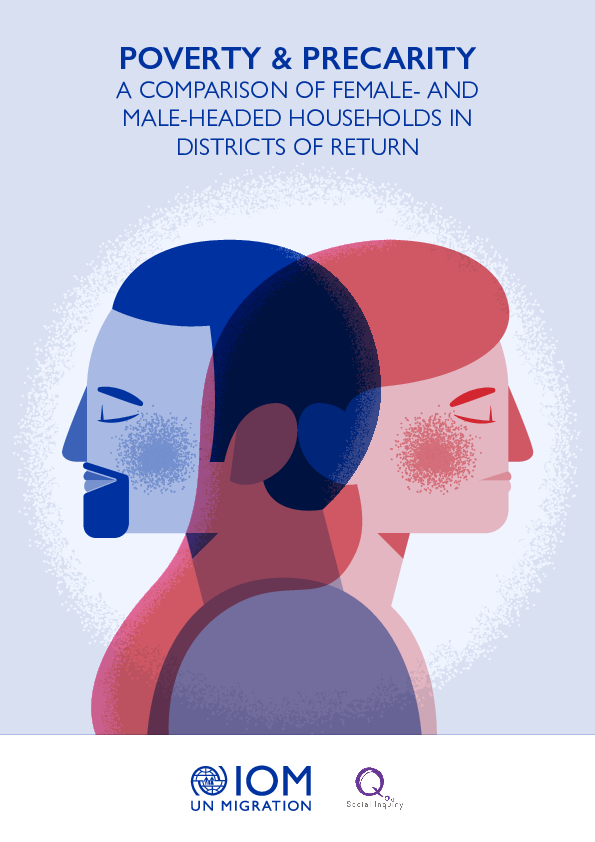
Contact
DTM Iraq, IraqDTM@iom.int
Language
English
Location
Iraq
Period Covered
Mar 01 2022
Apr 30 2022
Activity
- Survey
- Return Intention
This brief is part of a larger research project, Reimagining Reintegration, carried out by IOM Iraq and Social Inquiry, that explores the sustainability of returns across 14 districts hosting the largest shares of returnees in the country. These are, in descending order of returns, Mosul, Ramadi, Falluja, Telafar, Tikrit, Heet, Hawija, Hamdaniya, Shirqat, Kirkuk, Baiji, Sinjar, Khanaqin, and Balad. The findings presented here are drawn from an original household survey and roster of 2,260 returnee respondents in these districts collected between March and April 2022. The survey included a household module (applicable to the overall household situation), a personal module (gathering perceptions of the respondent), and a roster module (collecting personal characteristics of each household member), covering topics related to demographics, displacement and conflict history, safety and security, adequate standards of living, livelihoods and economic conditions, housing condition/restitution and tenure security, civil documentation, social cohesion and public participation, and remedies and justice. The outputs of this project also include an analysis of sustainable reintegration in districts of return and another brief on the impacts of conflict, climate change and the economy on agriculture in districts of return
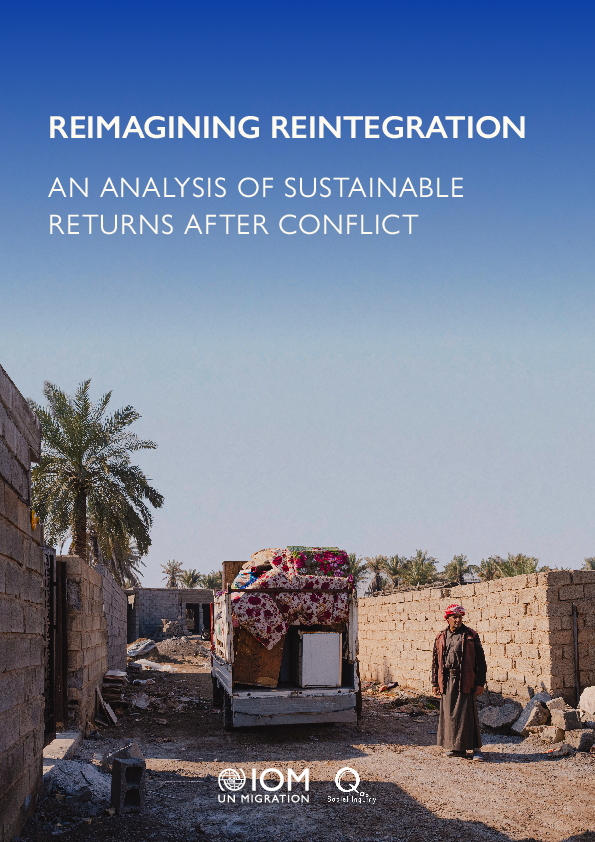
Contact
DTM Iraq, IraqDTM@iom.int
Language
English
Location
Iraq
Snapshot Date
Mar 22 2022
Activity
- Survey
- Return Intention
- Mobility Tracking
- Baseline Assessment
This report presents an overview of reintegration of returnees across the top 14 districts with the largest number of returnees; altogether, they represent more than 80% of the almost 5 million returnees that IOM’s Displacement Tracking Matrix estimated in March 20221 . This research was designed to obtain a statistically representative sample of the returnee population in each district with at most a 10% margin of error within a 95% confidence interval.

Contact
DTM Iraq, IraqDTM@iom.int
Language
English
Location
Iraq
Snapshot Date
Dec 30 2022
Activity
- Survey
- Return Intention
- Mobility Tracking
- Baseline Assessment
In February 2021, IOM Iraq, the Returns Working Group and Social Inquiry produced a report,Home Again?. The report analyzed the sustainability of reintegration of Iraqi families who had returned to their area of origin after being displaced due to the ISIL conflict. In line with the durable solutions framework developed by the Expert Group on Refugee and IDP Statistics (EGRIS), the report examined the extent to which sustainable reintegration had taken place across five areas.9 The study found that the main challenges to reintegration relate to housing, land and property (HLP); safety, security and social relations; and access to livelihoods and economic security. In 2021, IOM published a report and set of district profiles related to HLP, as well as a report focused on safety, security and social relations. Taken together, this series of reintegration reports – including this report focused on livelihoods and economic security – provides a comprehensive evidence base in support of the advancement towards sustainable reintegration for the 825,372 returnee families across the country.
The objective of this report is to strengthen the evidence-base related to the types of reintegration challenges related to livelihoods and economic security that returnees face across the country. The analysis is structured around the two relevant sub-criteria from the EGRIS framework, as follows: Livelihoods and employment and Economic Security.
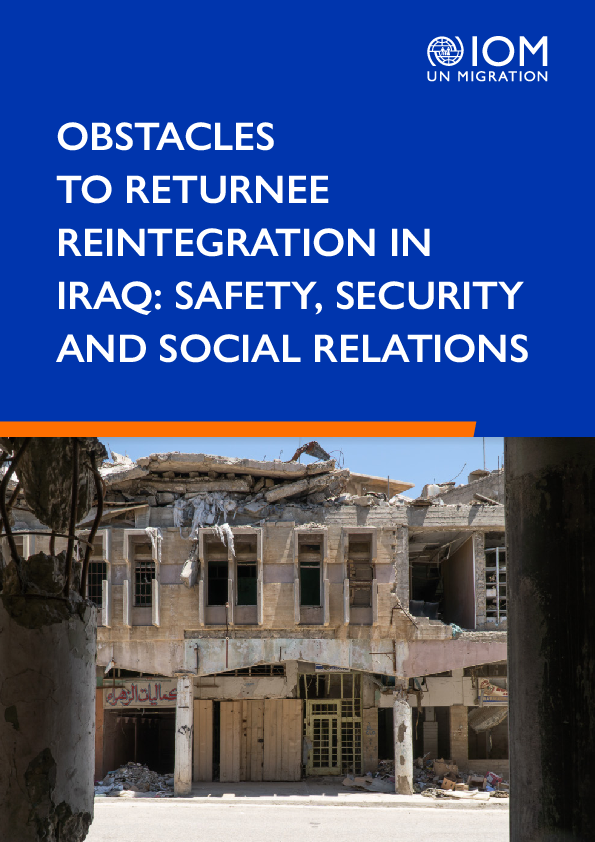
Contact
DTM Iraq, IraqDTM@iom.int
Language
English
Location
Iraq
Period Covered
Oct 01 2020
Sep 30 2021
Activity
- Survey
- Return Intention
- Mobility Tracking
- Baseline Assessment
In February 2021, IOM Iraq, the Returns Working Group and Social Inquiry produced a report, Home Again? Categorising Obstacles to Returnee Reintegration in Iraq. It analyzed the sustainability of reintegration for families who had returned to their area of origin after being displaced due to the ISIL conflict.5 In line with the durable solutions framework developed by the Expert Group on Refugee and IDP Statistics (EGRIS), the report examined the extent to which sustainable reintegration had taken place across five areas.6 Persistent issues related to safety, security and social relations were found to represent the most significant barriers to achieving sustainable reintegration amongst returnees in Iraq.
The objective of this report is to inform strategy development and planning in support of the sustainable reintegration of returnees in their area of origin. It provides a snapshot of the key reintegration challenges that returnees face related to safety, security and social relations, and highlights areas where these challenges are most prevalent. Where there is longitudinal data, the report also demonstrates how conditions have changed in the period between October 2020 and September 2021.
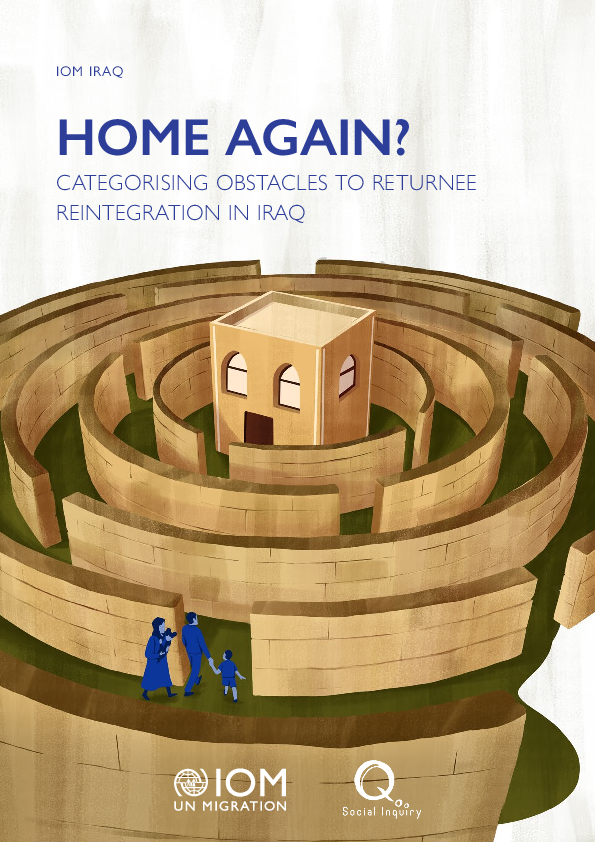
Contact
DTM Iraq, IraqDTM@iom.int
Language
English
Location
Iraq
Snapshot Date
Dec 31 2020
Activity
- Survey
- Return Intention
- Mobility Tracking
- Baseline Assessment
This report examines the prevalence of key obstacles for reintegration that returnee households face in Iraq as of mid-2020. These obstacles are grouped into five main criteria, as follows: safety, security & social relations, access to livelihoods & economic security, documentation, property resitution & compensation and adequate standard of living.
As of December 2020, Iraq has witnessed the return of 4.8 million internally displaced persons (IDPs) to their places of origin in the aftermath of the ISIL conflict. 1 Inter-Agency Standing Committee, IASC Framework on Durable Solutions for Internally Displaced Persons. Expert Group on Refugee and IDP Statistics, International Recommendations on IDP Statistics, background document to fifty-first session of the UN Statistical Commission, 3-6 March 2020. This is a significant returnee population and, while the movement home is a first step toward reintegration, it is not necessarily an indication of longer-term sustainability per se.1 The analysis in this report, by IOM Iraq, the Returns Working Group (RWG), and Social Inquiry, builds upon on and complements previous assessments on durable solutions, mainly with regards to obstacles to return as well as progress toward local integration for IDPs. The focus here is specifically on returnees and obstacles to their sustainable reintegration upon return.

Contact
dtmmozambique@iom.int
Language
English
Location
Mozambique
Period Covered
Apr 11 2024
Apr 16 2024
Activity
- Survey
- Return Intention
IOM’s Displacement Tracking Matrix in collaboration with SDPI conducted a Movement Intention Survey to 783 households hosting 3,136 individuals displaced from Chiure and Macomia districts in Cabo Delgado. Conflict and/or “fear of attacks” due to Non-State Armed Groups (NSAGs) in Cabo Delgado was the main trigger of displacement. At least 70% were displaced from Chiure Velho. 26% from Mazeze and 2% were from Ocua posto. Other postos of origin includes Chiure sede, Katapula, Quiterajo and Mucojo.
The objective of the assessment was to better understand the conditions of the IDP households in the current place of displacement and their short-term intentions. An on-going household verification exercise confirmed the presence of 1,965 households hosting 8,600 individuals in Chiure Posto. Females constitutes 55% of the IDPs whilst 45% are males. Children make up 58% of those remaining displaced within the district.
Pagination
- Previous page
- Page 4
- Next page
